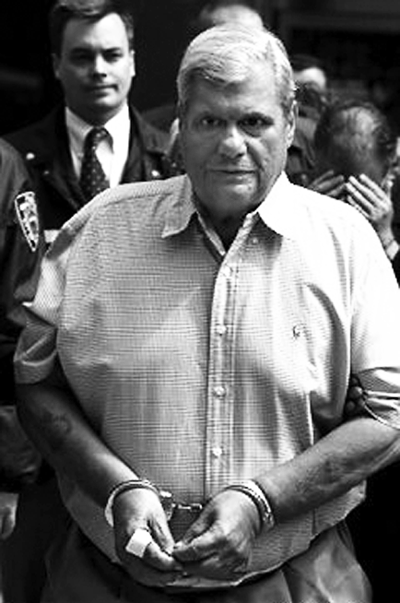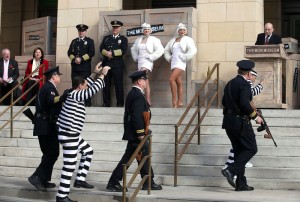Joey Merlino is the Mobster Next Door in Boca Raton

Joseph Merlino steps out onto the iron-railed balcony of his $400,000 townhouse. Bare-chested, ripped and clad in nothing but gray skivvies, he looks more like a former Calvin Klein underwear model than one of the most ruthless mobsters of his time. A year out of prison, Joseph Salvatore "Skinny Joey" Merlino isn't so skinny anymore. But he looks almost as boyish at 50 as at 39, when he was sentenced to 14 years in prison for racketeering. Back then, he was a 5-foot-3, 100-pound dapper young don who masterminded the bloody takeover of the Philadelphia mob. Today, he is a two-hour plane ride from the Southwest Philadelphia rowhouse where he grew up to become an underworld icon, both feared and eerily revered in the City of Brotherly Love.
"How'd ya find me?" he asks, his Philadelphia accent unmistakable.
Surely Merlino, who has survived at least a dozen attempts on his life and has been accused and acquitted of ordering the grisly murders of plenty of wise guys, knows the answer to his question: If you really want to, you can find just about anyone.
He grins and says he doesn't want to talk. This is something of a surprise, because Merlino is a mob star who, at least at one time, loved seeing himself in the spotlight so much that he used to ask friends to tape the TV news if there was a chance he would appear.
Once dubbed the "John Gotti of Passyunk Avenue," Merlino is now the ex-Mafioso, supposedly, of Boca's Broken Sound Boulevard, where he lives in a cookie-cutter development still partly under construction off Interstate 95 and Yamato Road.
"I mean no disrespect," he says, in a cliché as fitting as the Frank Sinatra tunes that neighbors say he blares in the middle of the night.
"Don't believe everything you read," he counters when asked about a possible movie deal about his gangster life, or to address evidence suggesting that he is back at the helm of the Philly-South Jersey La Cosa Nostra from his suburban South Florida outpost.
Mobsters have flocked to Florida since the first trees were planted on Palm Island, where Al Capone moved into a mansion in 1928. The state always has been open territory for organized crime, a wise-guy retreat where figures like Meyer Lansky and underlings from just about every crime family have angled for turf - from gambling to extortion to prostitution to money-laundering to running drugs.
Merlino says that he is in the carpet-installing business. The owner of his posh townhouse, Bruce DeLuca, is CEO of U.S. Installation Group, a primary flooring and carpeting subcontractor for Home Depot. Through a spokesperson, DeLuca said that he didn't lease the place to Merlino, doesn't know him and would never have rented the house had he known who would be living there.
The 2,900-square-foot, two-story, Mediterranean-style townhouse sits at the end of a cul-de-sac of former model homes in a community occupied by upper-middle-class, educated people who mostly work day jobs. It has an ornamental cross atop its tower-like roof.
But if Merlino has joined the work force, he isn't installing carpets 9-to-5, according to neighbors. They say he has thrown loud parties, with beefy men and scantily clad women coming and going at all hours. Last Christmas season, somebody threw his fully decorated tree - tinsel, balls and all, from his balcony onto the street.
"They're scary," said one neighbor who asked not to be identified. "We've had the police come several times. It's been very stressful living near them. There is always screaming and fighting."
Boca Raton police said that they have no record of any calls to the address, but if police were summoned because of noise, they wouldn't necessarily write up a report, said spokeswoman Sandra Boonenberg.
The neighbors say that what they find most disturbing are the banging noises in the middle of the night, as if furniture or equipment is being moved about.
"I'm not easily frightened," another neighbor said, when informed that a convicted mobster lived a few doors away. "I don't know who he is, but he does have a lot of visitors."
'Hometown Boy'
Retired Philadelphia Police Sgt. Walt Coughlin, who followed Merlino for much of his 47-year career, said that the former mob boss seemed to like everybody - except those who were out to kill him. His neighbors welcomed him, as he often gave them Christmas trees and offered to help them if they couldn't pay their heating bill."There were quite a few murders we thought he did, but there were no witnesses,'' said Coughlin. "Nobody would cooperate with police. They were afraid, and he was a hometown boy."
It's not clear whether Merlino's wife, Deborah Wells Merlino, and his two children are living with him in Boca. Neighbors say they haven't seen any children at the house.
Merlino appears to work out of his home. He named his Wi-Fi connection "Pine Barrens," a reference to the heavily forested area in New Jersey where organized criminals often disposed of bodies. It was the scene of one of the most famous - and frightening - episodes of "The Sopranos."
It would not surprise those who know Merlino if he is still living the "life."
"I can tell you that I would not want to live next door to Joey Merlino," said Stephen LaPenta, a retired Philadelphia police lieutenant who worked undercover as a mob informant, and infiltrated Merlino's inner circle. LaPenta, now retired and living in Florida, said that he still keeps tabs on the flamboyant ringleader.
"The Joey I know was a hard-drinking, womanizing, gambling drug user who would strangle you," he said.
Merlino had ruthless power, as well as panache.
"If Joey sneezed, 20 people would hand him a handkerchief," LaPenta said.
Why Boca?
So, why Boca Raton, a place without real cheesesteaks, Mummers and the Eagles?Organized-crime experts say that Merlino, one of the many Teflon dons who have beaten multiple murder raps, has a better shot of staying under the radar in Boca. He was high-profile in Philly, with an entourage of pretty women and bodyguards. He was always followed by police and undercover agents.
Richard Mangan, a professor at Florida Atlantic University's School of Criminology, said that Merlino is no stranger to South Florida. At one time, he was part of Nicodemo "Little Nicky" Scarfo's regime in Philadelphia. Scarfo owned a home in Fort Lauderdale, and Merlino is among those whose photo was taken on Scarfo's boat, the "Casa Blanca," also known as "The Usual Suspects.''
Mangan said it's likely that Merlino has been in charge of the family all along, even from prison.
"The speculation is that yeah, why wouldn't he be running things, especially in this digital age," Mangan said.
According to various media reports, Merlino has talked about getting into the restaurant business. In August, Don Michael Petullo, a former Las Vegas businessman who worked in the casino industry, registered a company, DNS Inc., at Merlino's Boca Raton address. Petullo, who could not be reached for comment, doesn't appear to be in the carpet business.
In February, a confidential FBI memo was leaked by the anti-secrecy group WikiLeaks that said that Merlino "appears to be restoring and developing significant relationships for a potential South Florida crew," and that he was getting involved in gambling/bookmaking activities.
Then, in May, a detention memo filed by prosecutors referred to a secretly recorded conversation among New Jersey mobsters discussing Merlino's status in the organization as the man in charge who would decide, after his release from prison, which candidates would be initiated into the mob. Joseph "Uncle Joe" Ligambi, until then considered the top boss, is recorded as saying that Merlino would "make" the guys he wants. Ligambi is now in prison.
Inviting trouble
A former boss of one of Florida's crime families, now retired, said that Merlino is inviting trouble by moving to Boca."I don't know who he thinks he is, but it's stupid, very stupid," said the ex-mobster, who spoke on the condition of anonymity. "Why Boca? He could go anywhere, Phoenix, even Central Florida." Boca, he said, will only create more police scrutiny of his dealings. "Boca is just too hot for someone like him."
The old-timer said that the brash and brazen Merlino will not be welcomed by the local La Cosa Nostra.
"I guarantee you that there are people out there who won't want him," he said.
New York's five organized-crime syndicates - the Gambino, Genovese, Bonanno, Colombo and Lucchese families - have always considered Florida to be "open," with no family claiming exclusive rights to operate.
But, many of the older bosses have either gone to jail or are dead. In the old days, the guys didn't want to attract attention, but young turks like Merlino enjoy the limelight, said the old boss.
During the time he was in prison, Merlino reportedly spent a lot of time in the gym, bulking up. Meanwhile, the mob was led by Ligambi, although speculation among law enforcement is that Ligambi was actually a figurehead for Merlino.
Merlino, released in 2011, served time in a Boca Raton halfway house before being freed last year.
If he is running the Philadelphia mob, he is likely doing so through associates still living in Philly and South Jersey, according to the confidential FBI memo. Merlino is prohibited from associating with known felons and is still on federally supervised release.
"The word we got is Joey has a benefactor, he has somebody pumping money into him. How else could he get out of prison and move into a $400,000 house and drive a Mercedes?'' LaPenta said. "It's trouble for South Florida in the sense that because Joey is there, others will follow."
http://www.philly.com/philly/news/20121001_Boca_Return__Is_Joey_Merlino_back_in_charge_.html?viewAll=y


























